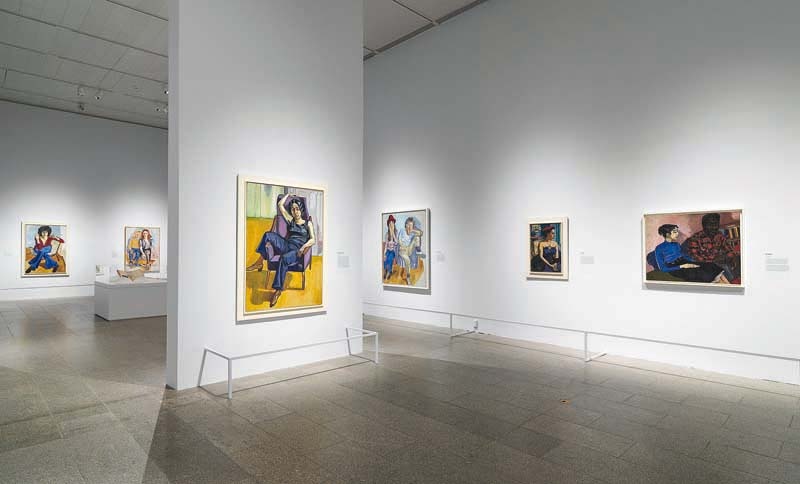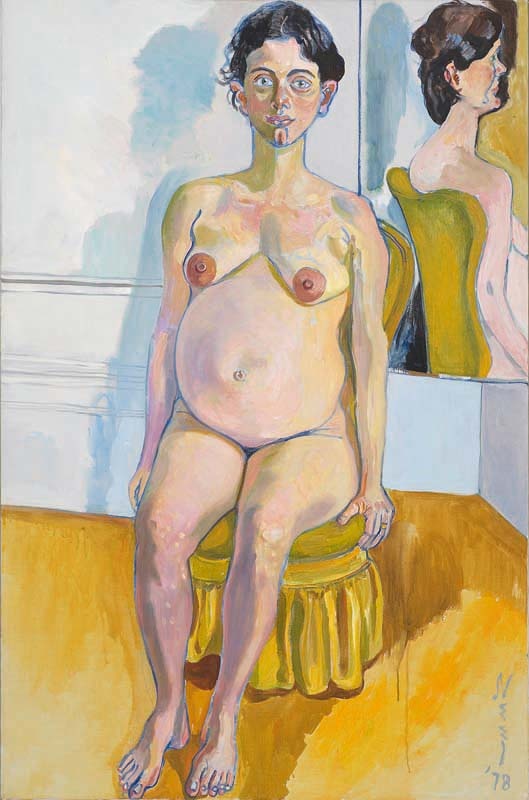SOCIALLY ENGAGED FIGURATION Antonia Pocock on Alice Neel at the Metropolitan Museum of Art, New York

“Alice Neel: People Come First,” Metropolitan Museum of Art, New York, 2021, installation view
The first painting that visitors to “Alice Neel: People Come First” at the Metropolitan Museum of Art encounter is a matter-of-fact nude portrait of a pregnant woman. The sitter, a friend of the artist’s named Margaret Evans, stares directly at the viewer with a stoic expression. She tensely clutches the seat of a dainty, skirted chair that seems to barely support the weight of her and the twins inside her distended abdomen. This inadequate, frilly seat might represent the feminine ideals that Neel’s series of pregnant nudes, painted during the second wave of feminism in the 1960s and ’70s, eschews. In these works (three more of which hang in galleries devoted to Motherhood and The Nude), Neel frankly depicts changes to the body during pregnancy – enlarged and darkened areolas, prominent veins in the breasts, the linea nigra that divides the belly, flushed and blotchy skin – that were rarely shown in art previously. The opening work thus concisely presents the thesis of the show: Neel’s commitment to figuration, once understood as traditional, was in fact radical.
When Neel began her artistic career during the Great Depression, painting the human figure was associated with radical leftist politics. In the exhibition, a gallery on the theme of New York City – where Neel lived and worked from 1931 until her death in 1984 – establishes her artistic roots in Depression-era social realism that called attention to the plight of the working class. Scenes of urban poverty and labor activism are among Neel’s output from the 1930s. She joined the Communist Party in 1935 and contributed illustrations to leftist periodicals through the 1960s, some of which are displayed in nearby cases. Unlike many New York artists who started as social realists in the 1930s, including Philip Guston and Jackson Pollock, Neel never abandoned people as her primary subject. In the 1940s and ’50s, when Abstract Expressionism dominated the New York art world, Neel painted gripping portraits of her neighbors in Spanish Harlem, where she moved in 1938. While Pop and Minimal art advanced a cool, slick aesthetic in the 1960s, Neel created personal, painterly portraits of her bohemian circle of acquaintances. It was not until the 1970s that Neel gained wide recognition, thanks to the support of feminist art historians such as Linda Nochlin and Cindy Nemser (whose portraits by Neel are included in the exhibition). Taking its title from Neel’s dictum that “people come first” in her art, the exhibition yokes her portrayal of diverse and often marginalized individuals to her advocacy of economic, racial, and gender equality.
Beyond the New York City gallery, which concludes with Neel’s tender portrait of two young Black boys in the home and studio she occupied on the Upper West Side from 1962 onward, the exhibition proceeds thematically. Though there is only a single gallery devoted to Motherhood, this theme permeates many sections of the exhibition – another reason that one of Neel’s daring pregnant nudes serves as an apt introduction. A gallery treating the subject of Home explores the tension between Neel’s duties as a mother and her artistic vocation, which she constantly juggled in apartments that doubled as her studios. This balancing act is most explicit in Neel’s 1943 portrait of her toddler son Hartley on a rocking horse, which includes a reflection of Neel in the mirror, painting and watching him. Nearby, a series of shockingly honest domestic scenes from the 1930s capture intimate moments with sexual partners that anticipate feminist erotic paintings from the 1970s by Joan Semmel.
A section focused on The Nude juxtaposes two of Neel’s pregnant nudes with her equally forthright naked portraits of herself at age eighty and of her infant grandson. This grouping expands the notion of motherhood to encompass grandmotherhood. Like pregnant bodies, elderly female bodies are uncommon in the history of art, where young, idealized female forms predominate. Neel’s Self-Portrait (1980), by contrast, relishes every wrinkle, fold, and sag of her aging figure. With similar candor, Neel painted her son Hartley’s baby Andrew lying on a blanket with his genitalia and reddened buttocks front and center.

Alice Neel, “Margaret Evans Pregnant,” 1978
A gallery titled The Human Comedy – a term Neel borrowed from Honoré de Balzac to describe the human struggles and vulnerabilities she sought to capture in her work – includes Neel’s sparse painting commemorating the death of her infant daughter in 1927, her nightmarish portrayal of the Well Baby Clinic where she gave birth to a second daughter in 1928, and her blunt portraits of her dying mother from 1953 and 1954. Echoing the distressed, lower-class mothers in Well Baby Clinic, the laboring woman in Childbirth (1939), on view in the Motherhood gallery, contorts in pain with a bleary expression on her face and dark bags under her eyes. Listlessness also marks the visage of a mother posing with her three young children in a nearby painting, The Spanish Family (1943). Neel did not shy away from the dreary moments of motherhood. She also challenged traditional depictions of mother and child from the Western canon by representing non-white subjects.
In addition to the trauma of birth and death, the works in The Human Comedy gallery portray a Puerto Rican tuberculosis patient, a victim of domestic violence, a Holocaust survivor, and pop artist Andy Warhol after sustaining gunshot wounds. Against mid-20th-century notions of the “human condition” that centered on the anxieties of straight white men, Neel’s “human comedy” attended to the suffering of a broad range of people. Peggy (1949), with its gruesome delineation of blueish-green bruises and reddish-purple scabs across the subject’s face, directly addresses partner and spousal abuse decades before Nan Goldin’s horrific photograph of her own battered face from 1984.
Though Neel’s focus on the human figure set her apart from the leading and largely abstract artists of her time, she often left passages of her paintings incomplete to reveal her process and the play between the abstract and representational capacities of paint. The poignant portrait Black Draftee (1965), on view in a gallery devoted to Neel’s formal experimentation, juxtaposes a fully painted face and hand with a body rendered in outline only. Though the painting’s incompleteness resulted from the subject’s being drafted to Vietnam after the first sitting, Neel declared it finished. The stark contrast between presence and absence conveys the existential threat faced by the sitter as a result of his conscription. A powerful protest against the Vietnam War, the work also highlights the hypocrisy of sending Black men to fight in a foreign war in the same year that the country finally began to dismantle Jim Crow–era disenfranchisement of Black Americans by passing the Voting Rights Act of 1965.
The largest gallery in the exhibition, titled Counter/Culture, includes Neel’s candid portraits of artists, activists, and other nonconformists in her social circle, the works for which she is most well-known. Spanning the 1930s through the 1970s, this section brings together the artist’s iconic paintings of union organizer Pat Whalen from 1935, civil rights leader James Farmer from 1964, drag performer and playwright Jackie Curtis with partner Ritta Redd from 1970, and Marxist-feminist artist Irene Peslikis from 1972, among others. Prominent and often blue contour lines, tantalizingly tactile paint, absorbing facial expressions, and expressive hands are consistent throughout the works, though the time period of each is unmistakable. Neel, as quoted in the wall text introducing a section called Art as History, proclaimed, “I believe in art as history. The swirl of the era is what you’re in and what you paint.” Neel captures and pierces through the self-presentation of her subjects, situating them in their time and place while also conveying their countercultural values that aligned with her own.
The Art as History gallery presents illuminating precedents for Neel. Paintings by Vincent van Gogh and Chaïm Soutine accentuate her singular combination of knobby outlines and expressive painterliness. A photograph by August Sander, known for his straightforward portraits of a cross-section of Weimar German society, presages Neel’s own approach to the genre. Mary Cassatt’s painting of a mother and child provides a counterpoint to Neel’s less sentimental representations of the same subject. Though focused on artists who paved the way for Neel, this gallery provokes the question of Neel’s legacy. In addition to Semmel and Goldin, mentioned previously, Jordan Casteel, whose Neel-esque portrait paintings from the 2010s were recently the subject of an exhibition at the New Museum in New York, immediately comes to mind. If critics and curators such as Henry Geldzahler (whose portrait by Neel is on view in the Counter/Culture gallery) once deemed Neel’s figurative painting outmoded, today it is a fertile model for young artists like Casteel who seek to infuse figuration with a commitment to social justice.
“Alice Neel: People Come First,” Metropolitan Museum of Art, New York, March 22–August 1, 2021.
